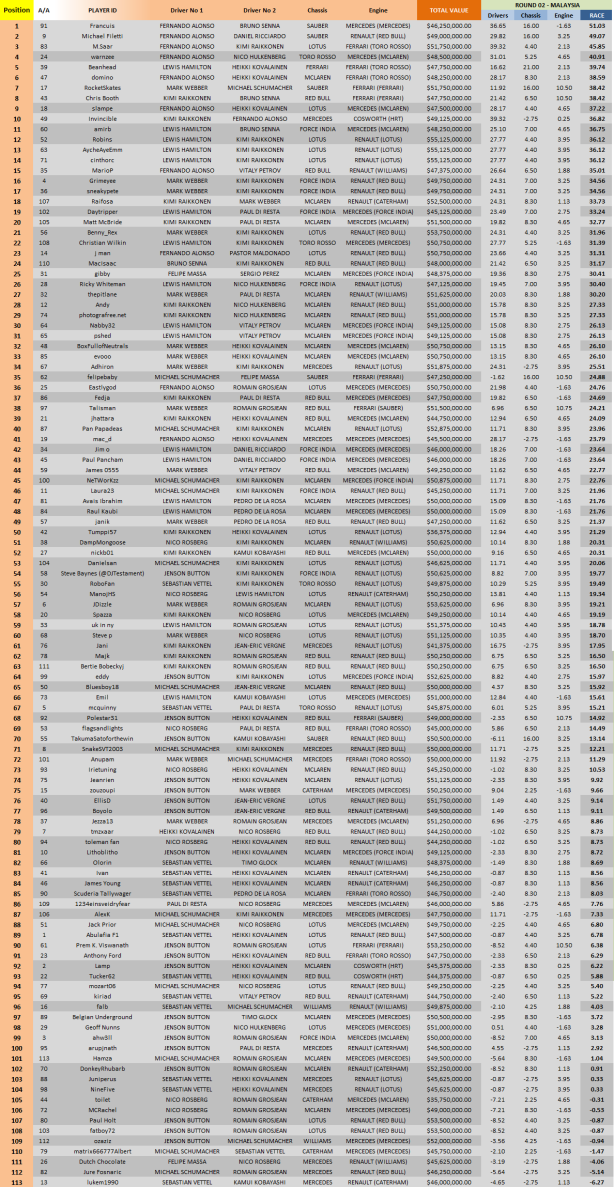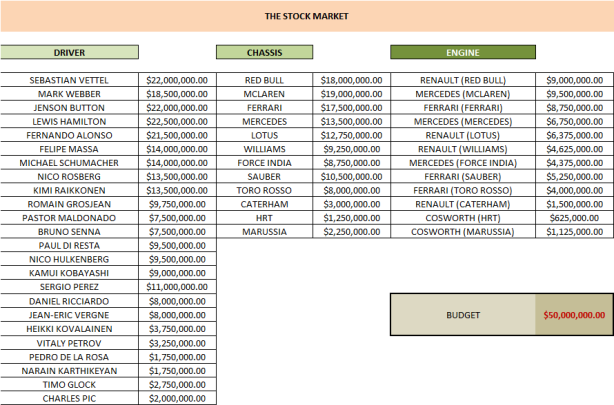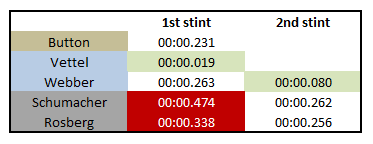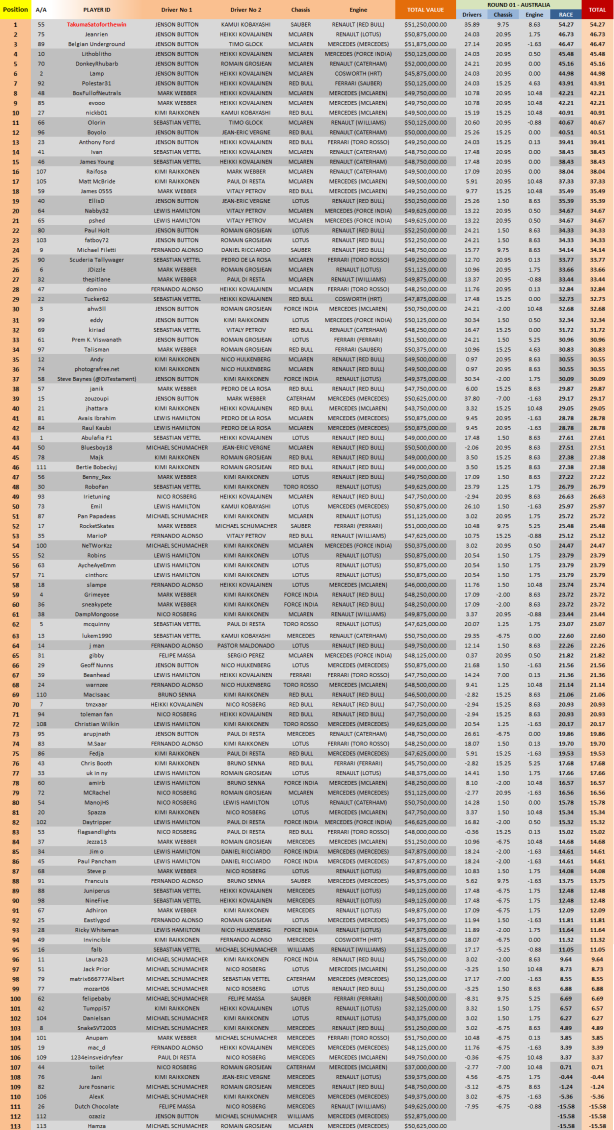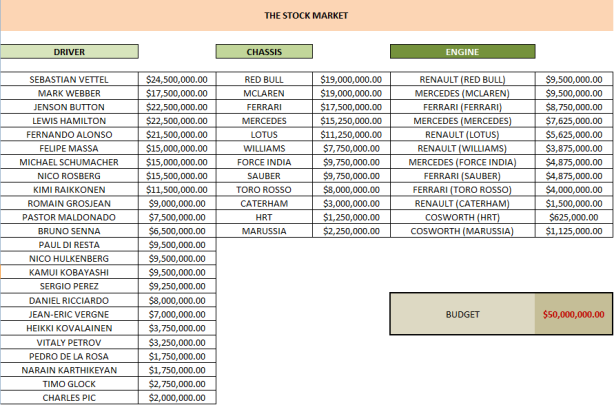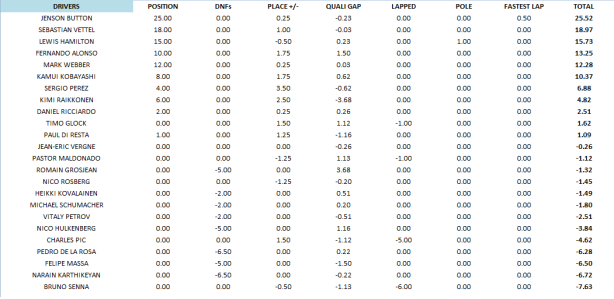The dust has settled on the season’s opening race, and there is a lot of head scratching going around the paddock. As was expected, the 1st race of the season opened the door to numerous more questions than those it provided answers for. You all know the results and you’ve all seen the race, so there’s no need to dwell on that, so we will move straight on with our analysis and opinion:
1. McLaren
Common wisdom from pre-season testing said that McLaren looked mighty in fast corners that required a lot of downforce, whereas they looked to be less impressive in slow corners that required good traction. However, in a track that is notorious for its slippery tarmac conditions and which is full of slow to medium speed corners, McLaren seemed to be in control of things. Had it not been for the Safety Car’s timing, in all probability they would have had both cars ahead of Sebastian Vettel. That’s ominous stuff ahead of Round 02 in Sepang, where McLaren are expected to hold an even bigger advantage over the rest of the field.
Jenson drove a methodical and clinical race, controlling the pace from the front. At the start of the race he built a comfortable gap to keep himself out of Lewis’ DRS activation range, he was clinical at the re-start after the SC, and towards the end of the race produced the fastest lap just to remind to everybody else who’s the daddy. Impressive stuff, almost Vettel-esque in its clinicality, especially coming from a driver who many expected to be playing second fiddle to Lewis Hamilton. He has, however, proved himself to be a shrewd, fast and consistent racing driver, who knows what he wants from a race and how to get it. He is constantly a couple of tenths down on Hamilton in qualifying, but in the races he’s been able to turn the situation around more often than not. Jenson’s last stint is characteristic of the way he controlled the pace: After the SC period, he slotted in the 1:29.8 – 1:30.2 bracket and then popped in a 1:29.6, 1:29.6 and 1:29.1 to end the race.
Lewis hasn’t been able, yet, to deal with the psychological penalty of coming from behind, or dropping down the order after a poor start. If he starts from the front and still leads after the 1st corner, he can be mighty, but he needs to maximize the opportunities that a race throws at him, especially when fighting further down the order. In Australia he was unable to challenge Button in terms of race pace, but he lost position to Vettel due to the safety car’s timing, which was unfortunate. McLaren appear to have the best package in 2012, therefore it’s up to Lewis to stamp his authority early on if he wants to be him winning a 2nd championship and not Jenson.
2. Red Bull
The good news for Red Bull is that Webber seems to have rediscovered his mojo. The bad news is that Red Bull, as a team, have lost it. During the last 2 days of pre-season testing, they introduced a radically different aerodynamic package, which included different exhaust outlets, and different sidepods construction, in an attempt to blow the floor, using the Coanda effect, essentially trying to copy McLaren’s solution and tailor it to their car. It was clear in the last 2 days that this didn’t work as well as they hoped, but the team persevered with it and raced it in Melbourne.
There are two ways of looking at it. The positive view is that Red Bull have had very little time to understand this package (they had reliability problems in the last 2 days of pre-season testing, and the majority of the free practices in Melbourne were wet), so they were naturally unable to extract the maximum out of it. The negative way of looking at it is that Red Bull have so much experience and depth in their aero department that this package really should have worked without the need for extensive testing. The fact that the drivers didn’t feel it was necessarily a step forward is not a very good sign.
It’s interesting to note that Red Bull genuinely struggled for pace in qualifying. Ok, Vettel made a small error on his last lap, but that would have only been enough to maybe jump his team-mate. The Mercs and the McLarens were out of reach. All their Q3 lap times were around the 1:25.7 mark, consistently about 8 tenths of a second off the ultimate pace. The car, especially during qualifying, was not planted to the ground like we’ve used to see from Red Bull in the past and both drivers had to work hard for their living behind the steering wheel. Thankfully, things were better in the race, with Vettel snatching 2nd place from Lewis during the SC phase. Vettel was closing in fast on Lewis and although it’s not clear if he would have passed him in the end, his pace was excellent at this stage. It will be very interesting to see the gap that Red Bull will have to McLaren in Sepang qualifying. Judging by Australia, we expect it to be along the same lines, or even larger. Red Bull are now phased with a situation whereby they cannot rely on their superior qualifying pace to start a race from the front and control it, but they will have to scramble for points and podiums, the way McLaren did in 2011.
It will be fascinating to see if, and how quickly, the Bulls can turn this around…
3. Mercedes
A lot of talk has been going on over the last couple of days about the degradation levels that Mercedes suffered in the race. However, it is clear to me, that this is not exactly the case. Sure, Mercedes’ problems originated from their tyres, and they were unable to showcase their pace in the race. I think at this point it’s interesting to show to you the following figure, which presents the lap times from the 4 theoretically top teams.
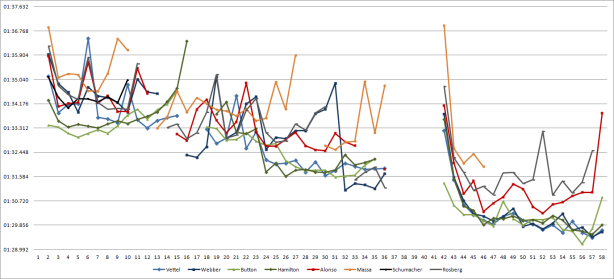
Melbourne, Australia - Round 01 - Race stints
As you can clearly see, in both Schumacher’s and Rosberg’s case, the tyres didn’t suffer from extreme degradation – they just never worked. Their opening laps on each stint were not fast at all, and the laptimes didn’t increase dramatically throughout the stint; they rather remained level, and slow. This tells us that Mercedes failed to hit the operating temperature window for their tyres, and we guess is that the conditions were too cool for them. Apparently, they never managed to inject the tyres with as much heat as required, and as a result the car was sliding around more. This, naturally, brings about more degradation, but a massive drop-off in lap times is not what we are seeing here. Schumacher’s first stint for example, up to the point that he retired, was a very consistent and relatively slow stint: 01:34.4, 01:34.0, 01:34.3, 01:34.3, 01:34.2, 01:34.4, 01:34.2 – 7 laps within 4 tenths of a second.
I believe that this problem is partly associated to their exhaust solution. Mercedes and Red Bull are clearly using part of their exhaust gas to warm the tyres and maintain them in the proper temperature – Red Bull even have small channels on the floor, in front of the tyres, to divert part of the fumes away from the tyres to avoid overheating. Mercedes are, once again, caught off-guard in that department, with their exhaust solution being far more conservative (trying to blow the upper part of the diffuser). Mercedes understood that the spirit of the 2012 technical rules was that the exhausts should not blow the floor, end of story, and designed their system on that provision. Red Bull and McLaren, however, have obeyed to the technicality (position and angle of the exhausts and related bodywork dimensions) but still tried to divert the flow to blow the floor and the brake ducts, which as we were predicting in our off-season car launch analyses have grown numerous fins and appendages.
On the plus side, Mercedes were genuinely fast in Australia. Ross Brawn’s disappointment after qualifying is a testament of how far the team has progressed since 2011. Michael’s Q3 lap would have easily been good enough for P3 on the grid, had he not been a bit hesitant in the last corner (his Q2 run was a bit slower than Nico’s due to a big oversteer moment at the last corner). With regards to Nico, I don’t think he’d shown any superior pace over Michael. Cars are sliding about more in 2012, which definitely helps Michael. Nico is more “absolute”, very committed to a line, a breaking point, a steering input, a gear change timing, which means that when the car is working he’s very, very hard to beat in qualifying. In varying friction and traction conditions though, Michael should have the ever-so-slight edge.
So, what should we expect from Mercedes in Sepang? I believe that they will not face the same problems with tyres, simply because Malaysia is hotter. It’s a bit strange that Mercedes should suffer from too cold temperatures, especially considering that all winter testing was done in cold conditions, but it may have to do also with the nature of the track as well (very green, slippery tarmac and not enough high-G corners to heat the tyres up). It will all come down to translating their qualifying pace into race pace. If they achieve that, they should be marginally ahead of the Bulls, but I fear McLaren is out of reach at the moment. Both McLarens were mighty through the quick Turn 12 and 13, so they should be at the top in Sepang.
Having said that, we’ve seen strangest things in the past…
4. Ferrari
Oh dear, where to start. Alonso’s race pace was decent, but nowhere near good enough to fight with the Bulls and the McLarens, and the only reason he finished ahead of Rosberg was because of Merc’s tyres issues. The way he dropped back from the top runners in the last stint shown above is characteristic of the pace that is missing from Ferrari at the moment. Qualifying was disastrous, especially considering that Melbourne with the many long straights is not a place that you would expect to see big differences in lap times. These gaps will only increase in the twisty, high-G corners of Malaysia, where you need a very efficient car, well-balanced aerodynamically. Alonso drove brilliantly throughout the weekend and, although he was lucky to get past so many cars at the start. Going into the 1st corner he was 13th. Going out of it, he was 8th… And then 6th after a couple of laps, following Maldonado’s and Grosjean’s tangle. If we look at it objectively, Alonso finished where he started (after the argy bargy of the first couple of laps), with Maldonado breathing down his back and only Rosberg behind, due to the tyres issue as we explained. All in all, it was a storming drive by Alonso, who clearly, clearly deserves a better car than what Ferrari are giving him.

Alonso @ Turn 01 - 13th going in, 8th coming out...
Ferrari’s true pace was reflected in Massa’s abysmal weekend. At one point, just before his last run in Q2, you could tell from the body language of his mechanics that they’d rather be in a locked cage with a bear that hasn’t been fed for the last month than to have to endure what was coming next. To call his driving and the car’s balance pathetic would be an understatement. Unfortunately, Massa’s weekend can be summed up as follows: An under-pressure driver, well past his prime, overdriving a car, that’s actually a dog. It’s a shame because Felipe is a genuinely likeable person. The way he fought and, more importantly, the way he accepted defeat during his 2008 championship campaign was majestic. It’s a shame having to watch him fight like that to keep his position, like a fish wriggling outside the water.
This has the makings of a lost year for Ferrari, unless they pull something spectacular out of the bag, quickly. It turns out that our pre-season analysis and predictions weren’t that far off, actually, so it will be interesting to see if the Reds can overcome their internal political jousting and get back on form before the championship is, once again, out of reach. The question that Ferrari should be asking themselves is: Is Fernando willing to stay loyal to Ferrari, especially if Mercedes and McLaren dominate the next seasons, like the trend is suggesting?
5. Lotus
One has to applaud Romain Grosjean for pulling a spectacular lap out of the bag in qualifying, but his inexperience showed in the race, allowing Maldonado a clear run down his inside at Turn 15, and that’s not the best idea in the world. I had predicted that Romain would have the upper hand on Kimi, and I saw over the weekend the kind of scruffiness and inconsistency in Kimi’s laps that can only be associated with a long absence from the sport. It takes quite a while for the movements to become completely automatic again, and Kimi’s not there. Yet. He drove a solid race, and positioned himself well inside the points, but one has to wonder what the young Frenchman could have achieved, especially given Mercedes’ problems. Romain had never before raced in Melbourne in his life, and he spent the majority of the free practice sessions driving around in the wet. And then qualified 3rd. How’s that for impressive?
Lotus’ race pace is difficult to judge, because they went for a very long first stint with Kimi; their tyre degradation, however, was exemplary. Again, Sepang should be able to shed some more light in their car’s abilities, especially during the race. They seem to have a fundamentally quick car and their in-season development pace will be crucial to keep up with the big guys. Red Bull are already one major aero package down the road, and Mercedes are, allegedly, preparing their own to deal with the exhausts issue.
The rest
I was most impressed (as most of you, I presume) with Williams. Again, common pre-season wisdom suggested that Williams would struggle in slow to medium speed corners, with poor traction and mediocre mechanical grip. And, boy, was that not the case in Melbourne. Maldonado’s race pace was stunning. I lost count of all the mistakes he made and the places he gave up, yet his pace was such that he was able to recover time and time again. This was a lost opportunity for Williams to score big points. I don’t want to beat my own drum, but as we had predicted here, Williams look to be at the sharp end of what we call midfield. In fact, had it not been for Alonso’s heroics, we would be placing Ferrari below Williams in terms of pure pace (race and quali). Senna simply needs to do a better job, simple as that.
Sauber also appear to be in a very good shape, showing promising speed in qualifying and even better race pace. Kamui and Sergio are very talented, mature and promising drivers, who will bring the car home in the points, if the car is capable of that. On that aspect, they have an important advantage over Williams.
Toro Rosso is amazing. Just mentally replace Vergne and Ricciardo with Alguersuari and Buemi, and you have a copy of the 2011 season: A decent midfield team, running in the boundaries of the top 10, enjoying the odd point when there’s carnage ahead, with both cars usually running line astern. It will be interesting to see if this pattern continues through the rest of the season, but I have to say that I was more impressed with Vergne, who had no previous F1 racing experience and managed to keep Ricciardo behind until the very last lap of the race.
Force India’s first race was disappointing, and they only managed a point after a crazy last lap, when Rosberg dropped from 8th to 12th. They have a very promising pair of drivers, although I am pretty confident that Nico has that extra “quality” above Di Resta. I’ ve always maintained that Di Resta was not, in fact, the rookie of the year in 2011 (my vote would have gone, wholeheartedly, to Sergio Perez) and that Nico Hulkenberg would, over the season, comfortably hold the edge in terms of pace. Let’s see if I’m right then, huh?
Finally, Caterham, as we have already said in our pre-season analysis, haven’t managed the leap required to reach the midfield battle, and are still the best part of a second slower than the slowest midfield runner. I was expecting more. Their cooling solution in Australia, considering the cool conditions there, was simply amateurish. What was it with all those gills and the big, gaping mouth at the back? Unless they don’t have enough cash to bring two types of cooling solutions for Australia and Malaysia, which I don’t believe is the case. Not much to say about Marussia.
As for HRT… I sympathize with their predicament. Not. This is your 3rd year on the sport, and your performance is simply disgraceful. You can’t call yourselves a F1 team and be slower than a GP2 front-runner. Get your act together, for the love of God.
Finally…
I guess that’s it for our post race analysis. If we want to give a few awards out there, then those would be the following:
Driver of the race: Fernando Alonso. For his entire weekend performance. For manhandling a temperamental, idiosyncratic car into submission. For punching way above his car’s weight. For fighting for places and points that he really shouldn’t be capable of.
Overtaking move of the race: Sebastian Vettel on Nico Rosberg, Lap 2. The approach to Turn 10 is notoriously difficult, because of the huge bumps right at the start of the braking zone, which unsettle the car and cause the brakes to lock. Outbraking Nico there, and passing on the outside, was simply staggering.
Daft moment of the race: Easy. Maldonado throwing away 6th place, a few corners from the finish line. By his own admission, he’d already settled for 6th after he failed to pass Alonso in Turn 3 (after the 2nd DRS zone). Williams desperately need drivers who can bring the car home in the points. Daft.
Thanks for tuning in…

